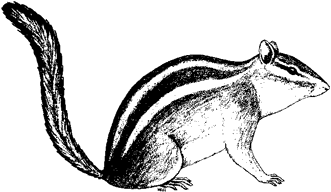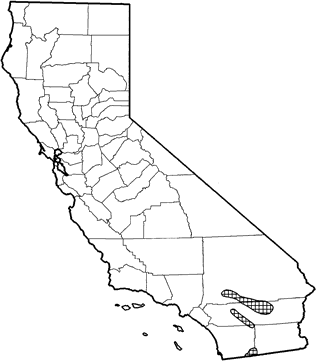
California Chipmunk
Distribution, Abundance, and Seasonality
The California chipmunk occurs in the San Bernardino, Eagle, San Jacinto, and Santa Rosa Mts. of southern California, and in extreme south-central California near the Mexican border in Imperial and San Diego cos. It is abundant in pinyon-juniper, chamise-redshank and mixed chaparral, and ponderosa pine habitats within its range. Elevational range is from 760-2600 m (2500-8500 ft). The species is uncommon to common in a variety of other habitats, including valley foothill hardwood and Joshua tree.

Range Map
Specific Habitat Requirements
Feeding: Food items reported include pinyon nuts, acorns, manzanita and juniper fruits. Probably eats a variety of seeds and fruits of grasses, forbs, and shrubs. Forages on the ground, and in shrubs and trees. May use feeding stations on logs and rocks.
Cover: Probably uses rocks, logs, brush, and trees for cover. Retreats to shade in when hot.
Reproduction: Probably nests in logs and underground burrows.
Water: Water sources other than food are not necessary, but are used if available.
Pattern: In Joshua tree habitat, it occurs mainly where there are rocks and junipers.
Species Life History
Activity Patterns: Diurnal. Seasonal pattern unknown. Probably active year-round in most of its range.
Seasonal Movements / Migration: None reported.
Home Range: No data found. Probably similar to T. merriami.
Territory: No data found. Probably similar to T. merriami.
Reproduction: Breeds January to June. Most females lactate in May. Litter size averages about 4 (Miller and Stebbins 1964).
Niche: This small, diurnal omnivore is similar to T. merriami, from which it has recently been separated (Callahan 1977). It occupies a wider range of habitats than most California chipmunks and, like T. minimus exhibits ecological release, using a wider range of habitats when it occurs alone than when it occurs with other chipmunks. North of San Gorgonio Pass, T. obscurus is replaced by T. merriami in plant communities higher than pinyon-juniper woodland (at about 2100 m/7000 ft). South of San Gorgonio Pass, the species are distributed in an opposite pattern: T. obscurus replaces T. merriami in plant communities higher than pinyon-juniper woodlands. In the Santa Rosa Mts., where T. obscurus occurs alone, it occupies the full range of suitable habitats, from the upper edge of desert succulent shrub through yellow pine forest (Callahan 1977). Predators probably include raptors, weasels, coyotes, foxes, and bobcats.
Sources & References
California Department of Fish and Game, 1999.
California's Wildlife, Sacramento, CA.
Written by: J. Duke, reviewed by: H. Shellhammer, edited by: R. Duke
Callahan, J. R. 1976. Systematics and biogeography of the Eutamias obscurus complex (Rodentia, Sciuridae). Ph.D. Thesis, Univ. Arizona, Tucson. 198pp.
Callahan, J. R. 1977. Diagnosis of Eutamias obscurus (Rodentia, Sciuridae). J. Mammal. 58:188-201. Miller, A. H., and R. C. Stebbins. 1964. The lives of desert animals in Joshua Tree National Monument. Univ. California Press, Berkeley. 452pp. Ryan, R. M. 1968. Mammals of Deep Canyon, Colorado Desert, California. Desert Museum, Palm Springs. 137pp.
California Animal Facts | California's Wildlife